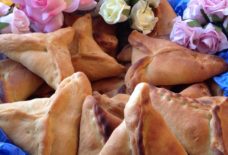The Ancient Religions and Culture Behind Ma’Moul
By: Blanche Shaheen / Arab America Contributing Writer
During Ramadan and Easter, there is a special cookie that has traveled through time since the age of the Egyptian Pharaohs. Today this cookie carries religious and cultural significance for both Arab Christians and Muslims, where they make these cookies only once a year.
That ancient cookie is called “Ma’moul”, and the alternative date ring cookie is called “Ka’ak bi Ajwa” (also known as semolina date cookies)
For Arab Christians, these cookies are supposed to symbolize Jesus’s crown of thorns. While that may sound morbid, Arab Christian families eat these cookies after going vegan for the 40 days of Lent to celebrate Jesus’s resurrection. They also eat these cookies during Epiphany.
Muslims eat this cookie to celebrate their Eid al-Fitr and evenings of Ramadan after breaking their fast. From start to finish, these cookies are tribal, in that they require a “tribe” of family and friends in an assembly line to mix and roll the dough and dates, shape the cookies into doughnut or spherical shapes, then decorate the cookies using special molds or tweezers.
The tribal traditions continue even after the baking is complete, as most families assemble over 60 cookies for the purpose of sharing them with other families. Just the smell of buttery semolina and sweet dates during baking evoke childhood memories for many Arabs. This is a quintessential part of maintaining Arab traditions no matter where the family lives on the globe. Each family has their own signature cookies, whether they add more cinnamon, mahlab, walnuts, or extra fancy designs depending on which cookie molds they use.
Preparing the dough and the dates are simple enough, and you can form a kitchen table gathering of helping hands to shape and decorate these cookies. Children especially love participating in making and eating these cookies. To decorate these cookies, use cookie tweezers or molds that you can order online or find in Middle Eastern markets. If you don’t have a market near you, you can use a fork to make decorative indentations instead.
For a video tutorial of how to make these cookies, click on the video here:
Notice these cookies do not have sugar in the actual dough. This is not by accident. The dates are so sweet there is no need for extra sugar. Also, adding sugar to the dough will cause the sugar to crystallize, leaving a crumbly, rather than a soft buttery cookie. In the Christian religion, the lack of sugar is deliberate, as the death and resurrection are bittersweet.
Recipe for Ma’Moul (Makes 35 Cookies):
3 cups semolina flour
1 cup ghee or clarified butter (no substitutions)
1 package fast-rising yeast
1 tsp sugar
½ cup of warm water
1 ½ lb date paste or pitted soft Mejdool dates
1 tsp. cinnamon
1/4 tsp. nutmeg
½ tsp mahleb (powdered cherry kernels see note)
Powdered sugar for dusting cookies
Incorporate both semolina and ghee by using a gentle rolling motion with your fingers. Cover with a cloth and let sit overnight.
The next day, combine 1 package of yeast, sugar, and warm water. Let’s rest while you work on rolling the dates.
To prepare the dates, place them in a food processor with nutmeg and cinnamon. Process until the dates make a thick paste. Or you can skip this step if you bought an already prepared date paste.
Oil your hands, and using your fingers, roll the date paste into logs about 3 inches long and ½ inch in diameter.
Meanwhile, add yeast mixture and the mahleb to the semolina mixture. If the semolina has hardened, then loosen up with a spoon until crumbly in texture. Work the dough into a thick paste with your fingers. You want a soft dough that doesn’t crack easily.
Now you are ready to assemble the cookies. Take a piece of dough, about a golf ball size, and roll into a cylinder about 4 inches long and 1 inch in diameter. Flatten with your finger. Place the log of date down the center, then pinch the dough up to enclose the date. Roll with your hands and pinch together both sides to make a doughnut shape.
Now you can decorate the cookie with dots using a fork or tweezers. Place on a baking sheet and bake at 400 degrees for 15 minutes or until lightly browned. These taste fabulous warm and dusted with powdered sugar. You can store any leftovers in a container for up to a week.
Blanche Shaheen is the author of the cookbook called “Feast In the Middle East, a Journey of Family and Cuisine” which you can order here: https://secure.mybookorders.com/mbo_index.php?isbn=9781545675113 She is also a journalist, and host of the popular cooking show called Feast in the Middle East. She specializes in Arab cuisine of the Levant and beyond. You can check out her cooking video tutorials at https://www.youtube.com/user/blanchetv Her recipes can also be found at: https://feastinthemiddleeast.wordpress.com/
Check out Arab America’s blog here!









